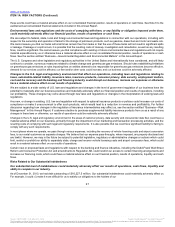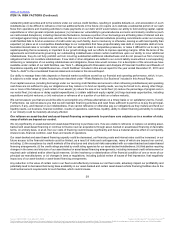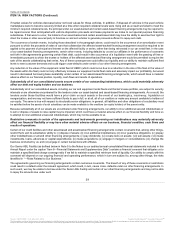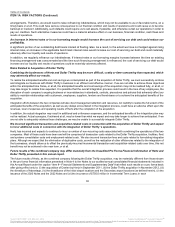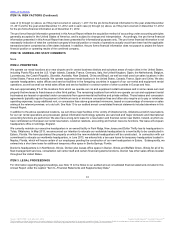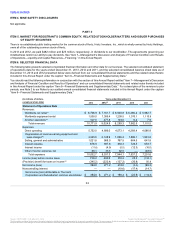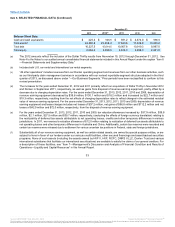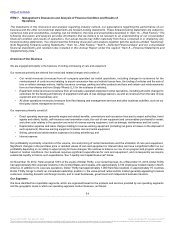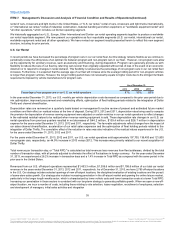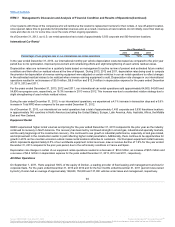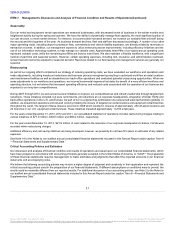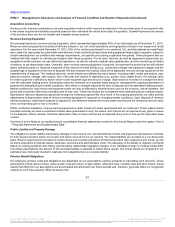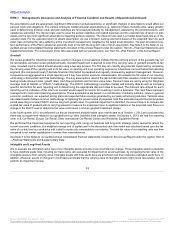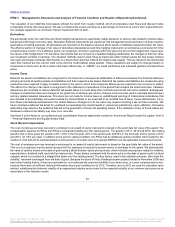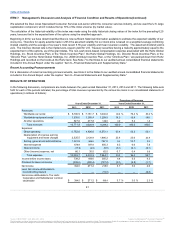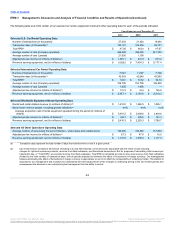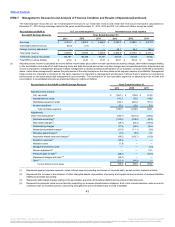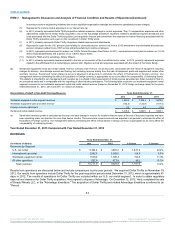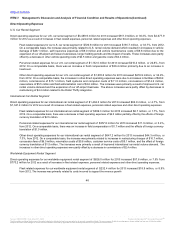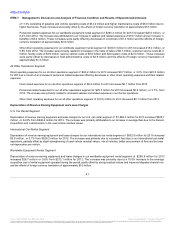Hertz 2013 Annual Report Download - page 40
Download and view the complete annual report
Please find page 40 of the 2013 Hertz annual report below. You can navigate through the pages in the report by either clicking on the pages listed below, or by using the keyword search tool below to find specific information within the annual report.
Table of Contents
Seasonality
Our car rental and equipment rental operations are seasonal businesses, with decreased levels of business in the winter months and
heightened activity during the spring and summer. We have the ability to dynamically manage fleet capacity, the most significant portion of
our cost structure, to meet market demand. For instance, to accommodate increased demand, we increase our available fleet and staff during
the second and third quarters of the year. As business demand declines, fleet and staff are decreased accordingly. A number of our other
major operating costs, including airport concession fees, commissions and vehicle liability expenses, are directly related to revenues or
transaction volumes. In addition, our management expects to utilize enhanced process improvements, including efficiency initiatives and the
use of our information technology systems, to help manage our variable costs. Approximately three-fifths of our typical annual operating costs
represent variable costs, while the remaining two-fifths are fixed or semi-fixed. We also maintain a flexible workforce, with a significant
number of part time and seasonal workers. However, certain operating expenses, including rent, insurance, and administrative overhead,
remain fixed and cannot be adjusted for seasonal demand. Revenues related to our fleet leasing and management services are generally not
seasonal.
Restructuring
As part of our ongoing effort to implement our strategy of reducing operating costs, we have evaluated our workforce and operations and
made adjustments, including headcount reductions and business process reengineering resulting in optimized work flow at rental locations
and maintenance facilities as well as streamlined our back-office operations and evaluated potential outsourcing opportunities. When we
made adjustments to our workforce and operations, we incurred incremental expenses that delay the benefit of a more efficient workforce and
operating structure, but we believe that increased operating efficiency and reduced costs associated with the operation of our business are
important to our long-term competitiveness.
During 2007 through 2013, we announced several initiatives to improve our competitiveness and industry leadership through targeted job
reductions. These initiatives included, but were not limited to, job reductions at our corporate headquarters, integration of Dollar Thrifty and
back-office operations in the U.S. and Europe. As part of our re-engineering optimization we outsourced selected functions globally. In
addition, we streamlined operations and reduced costs by initiating the closure of targeted car rental locations and equipment rental branches
throughout the world. The largest of these closures occurred in 2008 which resulted in closures of approximately 250 off-airport locations and
22 branches in our U.S. equipment rental business. These initiatives impacted approximately 10,700 employees.
For the years ended December 31, 2013, 2012 and 2011, our consolidated statement of operations includes restructuring charges relating to
various initiatives of $77.0 million, $38.0 million and $56.4 million, respectively.
For the year ended December 31, 2013, $21.9 million of costs related to the relocation of our corporate headquarters to Estero, Florida were
recorded within restructuring charges.
Additional efficiency and cost saving initiatives are being developed, however, we presently do not have firm plans or estimates of any related
expenses.
See Note 14 to the Notes to our audited annual consolidated financial statements included in this Annual Report under caption “Item 8
—Financial Statements and Supplementary Data.”
Our discussion and analysis of financial condition and results of operations are based upon our consolidated financial statements, which
have been prepared in accordance with accounting principles generally accepted in the United States of America, or “GAAP.” The preparation
of these financial statements requires management to make estimates and judgments that affect the reported amounts in our financial
statements and accompanying notes.
We believe the following accounting policies may involve a higher degree of judgment and complexity in their application and represent the
critical accounting policies used in the preparation of our financial statements. If different assumptions or conditions were to prevail, the
results could be materially different from our reported results. For additional discussion of our accounting policies, see Note 2 to the Notes to
our audited annual consolidated financial statements included in this Annual Report under the caption “Item 8—Financial Statements and
Supplementary Data.”
37
Source: HERTZ CORP, 10-K, March 31, 2014 Powered by Morningstar® Document Research℠
The information contained herein may not be copied, adapted or distributed and is not warranted to be accurate, complete or timely. The user assumes all risks for any damages or losses arising from any use of this information,
except to the extent such damages or losses cannot be limited or excluded by applicable law. Past financial performance is no guarantee of future results.


